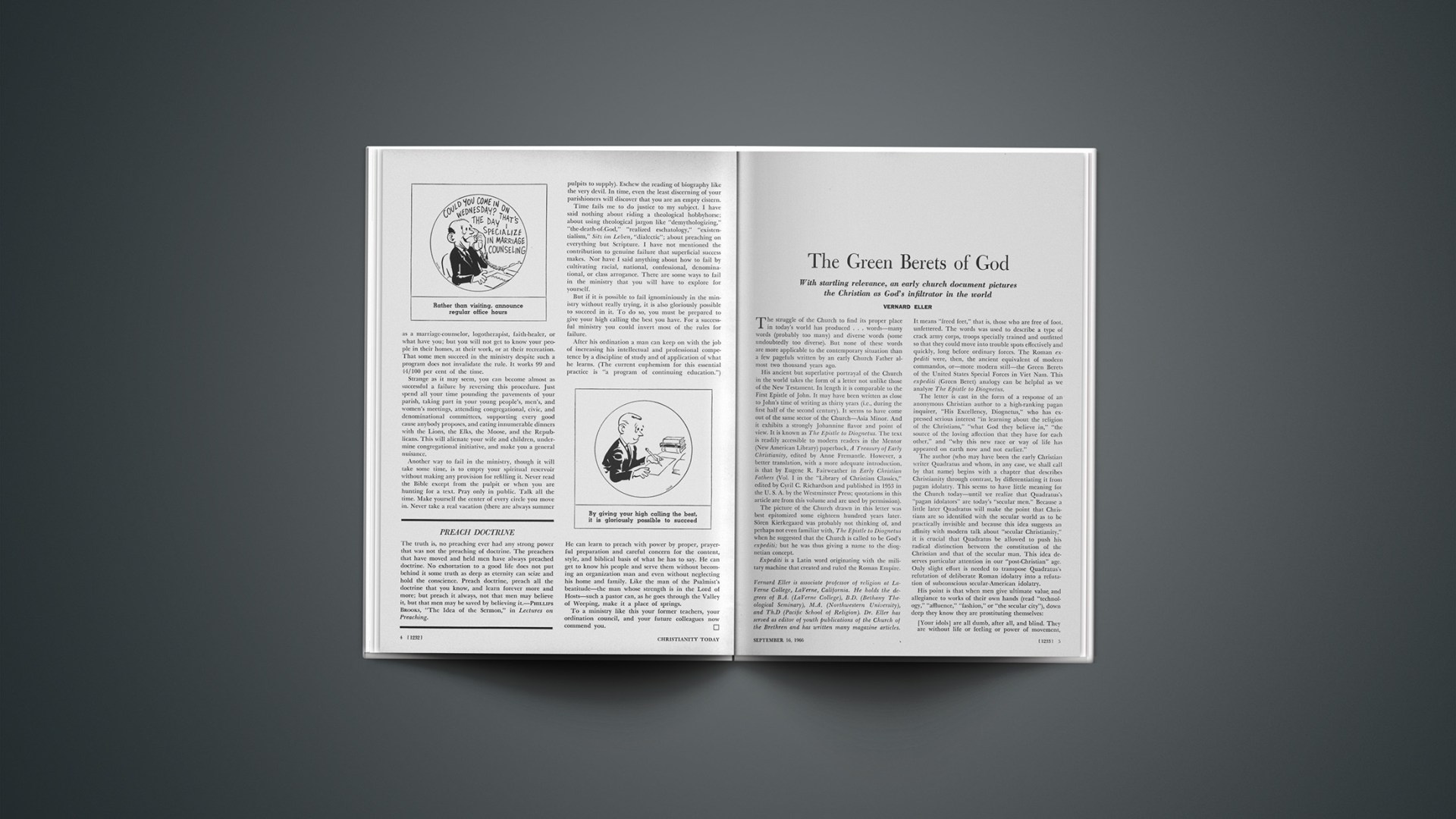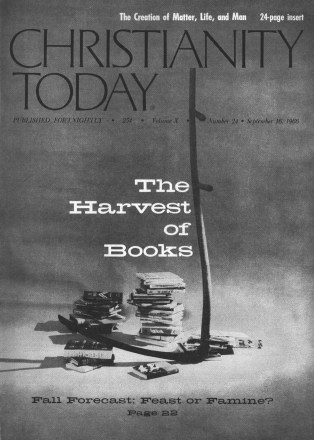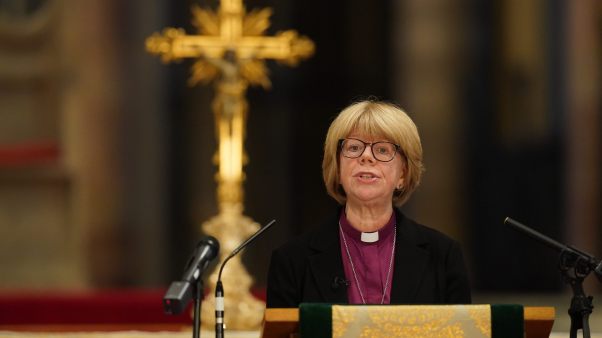With startling relevance, an early church document pictures the Christian as God’s infiltrator in the world
The struggle of the Church to find its proper place in today’s world has produced … words—many words (probably too many) and diverse words (some undoubtedly too diverse). But none of these words are more applicable to the contemporary situation than a few pagefuls written by an early Church Father almost two thousand years ago.
His ancient but superlative portrayal of the Church in the world takes the form of a letter not unlike those of the New Testament. In length it is comparable to the First Epistle of John. It may have been written as close to John’s time of writing as thirty years (i.e., during the first half of the second century). It seems to have come out of the same sector of the Church—Asia Minor. And it exhibits a strongly Johannine flavor and point of view. It is known as The Epistle to Diognetus. The text is readily accessible to modern readers in the Mentor (New American Library) paperback, A Treasury of Early Christianity, edited by Anne Fremantle. However, a better translation, with a more adequate introduction, is that by Eugene R. Fairweather in Early Christian Fathers (Vol. I in the “Library of Christian Classics,” edited by Cyril C. Richardson and published in 1953 in the U. S. A. by the Westminster Press; quotations in this article are from this volume and are used by permission).
The picture of the Church drawn in this letter was best epitomized some eighteen hundred years later. Sören Kierkegaard was probably not thinking of, and perhaps not even familiar with, The Epistle to Diognetus when he suggested that the Church is called to be God’s expediti; but he was thus giving a name to the diognetian concept.
Expediti is a Latin word originating with the military machine that created and ruled the Roman Empire. It means “freed feet,” that is, those who are free of foot, unfettered. The words was used to describe a type of crack army corps, troops specially trained and outfitted so that they could move into trouble spots effectively and quickly, long before ordinary forces. The Roman expediti were, then, the ancient equivalent of modern commandos, or—more modern still—the Green Berets of the United States Special Forces in Viet Nam. This expediti (Green Beret) analogy can be helpful as we analyze The Epistle to Diognetus.
The letter is cast in the form of a response of an anonymous Christian author to a high-ranking pagan inquirer, “His Excellency, Diognetus,” who has expressed serious interest “in learning about the religion of the Christians,” “what God they believe in,” “the source of the loving affection that they have for each other,” and “why this new race or way of life has appeared on earth now and not earlier.”
The author (who may have been the early Christian writer Quadratus and whom, in any case, we shall call by that name) begins with a chapter that describes Christianity through contrast, by differentiating it from pagan idolatry. This seems to have little meaning for the Church today—until we realize that Quadratus’s “pagan idolators” are today’s “secular men.” Because a little later Quadratus will make the point that Christians are so identified with the secular world as to be practically invisible and because this idea suggests an affinity with modern talk about “secular Christianity,” it is crucial that Quadratus be allowed to push his radical distinction between the constitution of the Christian and that of the secular man. This idea deserves particular attention in our “post-Christian” age. Only slight effort is needed to transpose Quadratus’s refutation of deliberate Roman idolatry into a refutation of subconscious secular-American idolatry.
His point is that when men give ultimate value, and allegiance to works of their own hands (read “technology,” “affluence,” “fashion,” or “the secular city”), down deep they know they are prostituting themselves:
[Your idols] are all dumb, after all, and blind. They are without life or feeling or power of movement, all rotting away and decaying. These are the things you call gods, the things you serve. You Gentiles adore these things, and in the end you become like them. That is why you hate the Christians, because they do not believe that these objects are gods. But is it not you yourselves who, when in your own thoughts you suppose that you are praising the gods, are in reality despising them?
Having cleared the ground for Christianity by refuting paganism, Quadratus now continues the process by refuting Judaism. At first (and perhaps second) thought this passage seems not merely irrelevant to the modern situation but positively detrimental to our current efforts in wiping out anti-Semitism. However, further thought makes it apparent that what Quadratus really is shooting at is “religion.” He now is concerned to drive a hard distinction between the Christian and the “religious” man, just as he earlier did between the Christian and the “secular” man.
SONNET OF THE MIDGET CROSSES
To die upon a charred and burning cross—
I am unworthy, Lord, the martyr’s name!
To count all this world’s gain but loss,
could my weak soul bear out the Huss-like shame?
Each day holds midget crosses, one by one.
Let me not flinch, as fingers point the match,
and I, the object of my torment’s fun,
behold the blue-white flame leap from the scratch.
And as the wood chars deep within my soul,
burn out the worthless chaff of my desire:
the choking dross of every human goal
be now consumed upon thine altar fire.
And through the midget crosses of each day,
let me now walk the living martyr’s way.
WILMA W. BURTON
“Religion,” he says, represents our human desire and tendency to invent rituals, creeds, and good deeds that will in some sense “buy off” God, inveigle us into his favor, get him into our debt and under our control. All of this is simply a more subtle form of idolatry. To give Quadratus’s words the value they can have for Green Beret Christians, all we need do is leave the Jews out of account and direct his thought toward the whole mass of “church business” that so often passes for Christianity:
[The Jews] arc right in thinking that they adore the one God of all things and honor him as Lord; but since they offer this worship more or less in the same manner [as the Gentiles do to their idols], they are completely mistaken. While the Greeks provide a proof of their own lack of understanding, by making offerings to senseless and deaf objects, the Jews themselves might perhaps consider it folly rather than piety if they only recognized that they were offering gifts to God just as if he needed them.… [The Greeks] think that they are offering something to objects which in reality cannot appropriate the honor, while [the Jews] imagine that they are giving something to him who has need of nothing.
Not secular, not religious, but Christian. And as Quadratus moves now into positive description, he gives what is surely one of the most moving descriptions of the Christian life ever drawn:
For Christians cannot be distinguished from the rest of the human race by country or language or customs. They do not live in cities of their own; they do not use a peculiar form of speech; they do not follow an eccentric manner of life. This doctrine of theirs has not been discovered by the ingenuity or deep thought of inquisitive men, nor do they put forward a merely human teaching, as some people do. Yet, although they live in Greek and barbarian cities alike, as each man’s lot has been cast, and follow the customs of the country in clothing and food and other matters of daily living, at the same time they give proof of the remarkable and admittedly extraordinary constitution of their own commonwealth.
The basic art of the Christian, as of the Green Beret, is infiltration. As the Green Beret “dissolves into the landscape” of the disputed territory he aims to secure, so does the Christian into the disputed territory of this world. Yet, be he ever so inconspicuous, ever so “natural” a part of his environment, nevertheless every move, every objective, every purpose of the Green Beret is oriented elsewhere; his orders come from “outside.” He is not what he appears to be, not a native but an invader. And regarding Christians, this is the same point Quadratus makes as he continues:
They live in their own countries, but only as aliens. They have a share in everything as citizens, and endure everything as foreigners. Every foreign land is their fatherland, and yet for them every fatherland is a foreign land. They marry, like everyone else, and they beget children, but they do not cast out their offspring. They share their board with each other, but not their marriage bed. It is true that they are “in the flesh,” but they do not live “according to the flesh.” They busy themselves on earth, but their citizenship is in heaven. They obey the established laws, but in their own lives they go far beyond what the laws require.
The Green Beret is obviously a man on the spot—the spot of pressure and tension, of danger and vulnerability. It is precisely because he has what it takes to stand the gaff and take care of himself under the most trying conditions that he is chosen to wear the green beret. Quadratus sees that the Christian’s undercover role of being simultaneously in but not of the world also puts him very much on the spot. But at the same time Quadratus puts his finger on the essential difference between the Christian and the Green Beret. Because the Green Beret is a representative of the Armed Forces of Carnal Warfare, his assignment at the trouble spot is to “dish it out.” But because the Christian is a representative of the Unarmed Forces of Suffering Love, his assignment at the trouble spot is not to resist one who is evil but to love his enemies and pray for those who persecute him:
They love all men, and by all men are persecuted. They are unknown, and still they are condemned; they are put to death, and yet they are brought to life. They are poor, and yet they make many rich; they are completely destitute, and yet they enjoy complete abundance. They are dishonored, and in their very dishonor are glorified; they are defamed, and are vindicated. They are reviled, and yet they bless; when they are affronted, they still pay due respect. When they do good, they are punished as evildoers; undergoing punishment, they rejoice because they are brought to life.
The role of the Church in the world, then, Quadratus sums up with a most effective figure of speech. Yet its full impact depends upon a knowledge of how he pictures the human “soul.” He does not think of it, as I suspect most of us do, as a sort of invisible stainless-steel nugget hidden somewhere deep within a person. He sees the soul as an invisible counterpart, a spiritual “shadow-man” that is precisely congruous and coincident with the physical man in whom it dwells.
To put it simply: What the soul is in the body, that Christians are in the world. The soul is dispersed through all the members of the body, and Christians are scattered through all the cities of the world. The soul dwells in the body, but does not belong to the body, and Christians dwell in the world, but do not belong to the world. The soul, which is invisible, is kept under guard in the visible body; in the same way, Christians are recognized when they are in the world, but their religion remains unseen. The flesh hates the soul and treats it as an enemy, even though it has suffered no wrong, because it is prevented from enjoying its pleasures. The soul loves the flesh that hates it, and its members; in the same way, Christians love those who hate them. The soul is shut up in the body, and yet itself holds the body together; while Christians are restrained in the world as in a prison, and yet themselves hold the world together.… It is to no less a post than this that God has ordered them, and they must not try to evade it.
Called to be the Green Berets of God!
In his concluding chapters, Quadratus addresses himself to a question we perhaps too often ignore in our discussion about being the Church in the world—namely, “How do Christians get that way!” We seem to assume that the matter simply is one of our own deciding, that turning to the world is an act for the Church to perform at its own initiative and under its own power. On the contrary, Quadratus insists that the Christian life he has described is not an earthly discovery nor a human accomplishment; it is the work of God himself. “Nor, as one might suppose, did he do this by sending to men some subordinate.… Rather, he sent the Designer and Maker of the universe himself.…”
Now, did he send him, as a human mind might assume, to rule by tyranny, fear, and terror? Far from it! He sent him out of kindness and gentleness, like a king sending his son who is himself a king. He sent him as God; he sent him as man to men. He willed to save man by persuasion, not by compulsion, for compulsion is not God’s way of working. In sending him, God called men, but did not pursue them; he sent him in love, not in judgment.… In the former time he had proved to us our nature’s inability to gain life; now he showed the Savior’s power to save even the powerless, with the intention that on both counts we should have faith in his goodness, and look on him as Nurse, Father, Teacher, Counselor, Healer, Mind, Light, Honor, Glory, Might, Life—and that we should not be anxious about clothing and food.
It is more what has happened to the Christians, their experiencing of God’s loving action in Jesus Christ, than what they do, that qualifies them for the career of a Green Beret. Yet in this experience they find the highest destiny open to human beings, an honor and a glory unguessed even by the wearers of Uncle Sam’s green berets. For the Christians become imitators of God, the God who himself (if I may put it thus) wears the Green Beret.
If you too yearn for this faith, then first of all you must acquire full knowledge of the Father. For God loved men, and made the world for their sake, and put everything on earth under them. He gave them reason and intelligence, and to them alone he entrusted the capacity for looking upward to him, since he formed them after his own image. It was to them that he sent his only-begotten Son, and to them that he promised the Kingdom in heaven which he will give to those who love him. And when you have acquired this knowledge, think with what joy you will be filled! Think how you will love him, who first loved you so! And when you love him, you will be an imitator of his goodness. And do not be surprised to hear that a man can become an imitator of God. He can, because God wills it. To be happy does not, indeed, consist in lording it over one’s neighbors, or in longing to have some advantage over the weaker ones, or in being rich and ordering one’s inferiors about. It is not in this way that any man can imitate God, for such things are alien to his majesty. But if a man takes his neighbor’s burden on himself, and is willing to help his inferior in some respect in which he himself is better off, and, by providing the needy with what he himself possesses because he has received it from God, becomes a god to those who receive it—then this man is an imitator of God.










